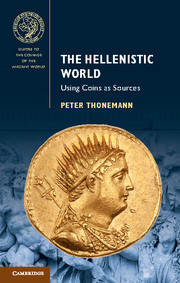Book contents
- Frontmatter
- Contents
- List of maps
- List of figures
- Preface
- List of abbreviations
- Maps
- Part I Globalization
- Part II Identity
- Part III Political economy
- Part IV Ideology
- Guide to further reading
- Appendices (by Andrew Meadows)
- 1 Glossary of numismatic terms
- 2 Denominational systems
- 3 The manufacture and material of ancient coinage
- Bibliography
- Index
3 - The manufacture and material of ancient coinage
from Appendices (by Andrew Meadows)
Published online by Cambridge University Press: 05 December 2015
- Frontmatter
- Contents
- List of maps
- List of figures
- Preface
- List of abbreviations
- Maps
- Part I Globalization
- Part II Identity
- Part III Political economy
- Part IV Ideology
- Guide to further reading
- Appendices (by Andrew Meadows)
- 1 Glossary of numismatic terms
- 2 Denominational systems
- 3 The manufacture and material of ancient coinage
- Bibliography
- Index
Summary
Ancient coinage was hand made, in two senses. First, the actual process of striking the coins was carried out by hand. A coin was produced by placing a blank piece of metal on a die set within an anvil, or similar anchoring device. This is known to numismatists as the ‘obverse die’, or sometimes the ‘anvil die’. A second die on the end of a punch (the ‘reverse die’) was then placed on top of the blank and hit forcefully with a hammer, probably several times. The result was a flat, roundish piece of metal with, usually, designs or ‘types’ on both sides (Fig. 10.1).
The second hand-crafted element of coin production was the engraving of the designs that appeared on ancient coins. Unlike modern coin dies, which are all mechanically copied from a single master engraving, each ancient die was individually engraved and thus different from every other. These two elements of hand production create an interesting mixture of results. On the one hand, there is an individuality of design of dies, which allows us to trace the products of an ancient mint in a way that is impossible for modern coins. It also allows us to count the number of dies used to produce a particualr coinage, and thus to quantify it. On the other hand, manual striking, although not nearly so fast as modern machine production, allows for the production of thousands of identical or closely similar objects within a very short space of time. Coins, in this sense, are one of the very rare examples from the pre-modern world of mass production.
The substance of ancient coinage was also profoundly different from that of today's coins. In origin, coinage was a monetary instrument of intrinsic value. The earliest coins, produced in Asia Minor from the mid-seventh to mid-sixth century BC were made of carefully controlled amounts of electrum, the alloy of gold and silver. Subsequently, most probably under the influence of the prevailing monetary tradition of the Near East, coinage came largely to be produced in high-quality silver (from the latter part of the sixth century BC through to the first century AD), with gold being produced when circumstances of supply or demand particularly prompted it.
- Type
- Chapter
- Information
- The Hellenistic WorldUsing Coins as Sources, pp. 199 - 200Publisher: Cambridge University PressPrint publication year: 2016

